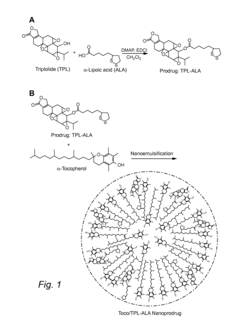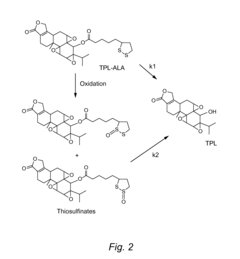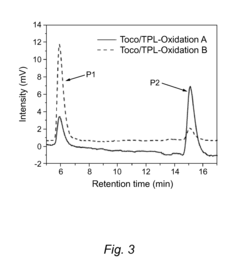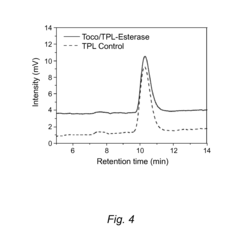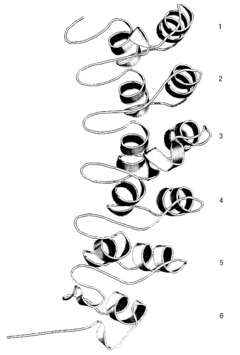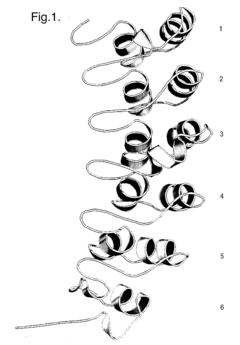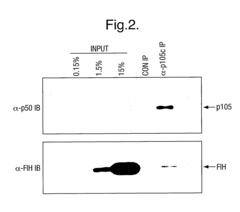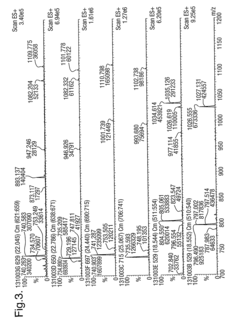Hypochlorous Acid: Mechanisms in Enzyme Regulation Studies
AUG 4, 20259 MIN READ
Generate Your Research Report Instantly with AI Agent
Patsnap Eureka helps you evaluate technical feasibility & market potential.
HOCl in Enzyme Regulation: Background and Objectives
Hypochlorous acid (HOCl) has emerged as a crucial molecule in the field of enzyme regulation studies, with its significance rooted in its unique chemical properties and biological functions. This powerful oxidant, naturally produced by the immune system, plays a vital role in host defense mechanisms against pathogens. The study of HOCl's mechanisms in enzyme regulation has gained momentum over the past few decades, driven by the growing understanding of its involvement in various physiological and pathological processes.
The primary objective of research in this area is to elucidate the intricate ways in which HOCl interacts with enzymes, modulating their activity and influencing cellular functions. This encompasses investigating the direct effects of HOCl on enzyme structure and function, as well as exploring its role in signaling cascades that regulate enzyme expression and activity. Understanding these mechanisms is crucial for developing novel therapeutic strategies and improving our comprehension of oxidative stress-related diseases.
The evolution of HOCl research in enzyme regulation can be traced back to early observations of its antimicrobial properties. Initially, the focus was primarily on its role in neutrophil-mediated killing of microorganisms. However, as analytical techniques advanced, researchers began to uncover the broader implications of HOCl in cellular biochemistry. This led to a paradigm shift, recognizing HOCl not just as a destructive agent, but as a sophisticated regulator of enzyme function.
Recent technological advancements have significantly contributed to the progress in this field. High-resolution mass spectrometry, X-ray crystallography, and advanced computational modeling have enabled researchers to study HOCl-enzyme interactions at the molecular level. These tools have revealed the specific amino acid modifications induced by HOCl and their consequent effects on enzyme structure and catalytic activity.
The current research landscape is characterized by a multidisciplinary approach, combining biochemistry, molecular biology, and biophysics to unravel the complexities of HOCl-mediated enzyme regulation. Key areas of investigation include the identification of HOCl-sensitive enzymes, the elucidation of oxidation mechanisms, and the exploration of cellular responses to HOCl-induced modifications.
As we delve deeper into the mechanisms of HOCl in enzyme regulation, the potential applications of this knowledge continue to expand. From developing new strategies for combating antibiotic-resistant bacteria to understanding the role of HOCl in age-related diseases, the implications of this research are far-reaching. The ongoing studies aim not only to enhance our fundamental understanding of cellular processes but also to pave the way for innovative therapeutic interventions in various pathological conditions.
The primary objective of research in this area is to elucidate the intricate ways in which HOCl interacts with enzymes, modulating their activity and influencing cellular functions. This encompasses investigating the direct effects of HOCl on enzyme structure and function, as well as exploring its role in signaling cascades that regulate enzyme expression and activity. Understanding these mechanisms is crucial for developing novel therapeutic strategies and improving our comprehension of oxidative stress-related diseases.
The evolution of HOCl research in enzyme regulation can be traced back to early observations of its antimicrobial properties. Initially, the focus was primarily on its role in neutrophil-mediated killing of microorganisms. However, as analytical techniques advanced, researchers began to uncover the broader implications of HOCl in cellular biochemistry. This led to a paradigm shift, recognizing HOCl not just as a destructive agent, but as a sophisticated regulator of enzyme function.
Recent technological advancements have significantly contributed to the progress in this field. High-resolution mass spectrometry, X-ray crystallography, and advanced computational modeling have enabled researchers to study HOCl-enzyme interactions at the molecular level. These tools have revealed the specific amino acid modifications induced by HOCl and their consequent effects on enzyme structure and catalytic activity.
The current research landscape is characterized by a multidisciplinary approach, combining biochemistry, molecular biology, and biophysics to unravel the complexities of HOCl-mediated enzyme regulation. Key areas of investigation include the identification of HOCl-sensitive enzymes, the elucidation of oxidation mechanisms, and the exploration of cellular responses to HOCl-induced modifications.
As we delve deeper into the mechanisms of HOCl in enzyme regulation, the potential applications of this knowledge continue to expand. From developing new strategies for combating antibiotic-resistant bacteria to understanding the role of HOCl in age-related diseases, the implications of this research are far-reaching. The ongoing studies aim not only to enhance our fundamental understanding of cellular processes but also to pave the way for innovative therapeutic interventions in various pathological conditions.
Market Demand for HOCl-Based Enzyme Regulation
The market demand for HOCl-based enzyme regulation has been steadily growing, driven by its potential applications in various industries. The healthcare sector, particularly in wound care and disinfection, has shown significant interest in HOCl-based solutions due to their effectiveness and safety profile. Hospitals, clinics, and long-term care facilities are increasingly adopting HOCl-based products for surface disinfection and wound management.
In the food and beverage industry, there is a rising demand for HOCl as a natural antimicrobial agent. Food processors and manufacturers are exploring its use in sanitizing equipment, extending shelf life, and ensuring food safety. The agriculture sector has also recognized the potential of HOCl in crop protection and post-harvest treatment, leading to increased market interest.
The water treatment industry is another key driver of HOCl demand, with applications in municipal water systems, swimming pools, and industrial water treatment. The ability of HOCl to effectively disinfect water without harmful by-products has made it an attractive alternative to traditional chlorine-based methods.
The cosmetics and personal care industry has begun incorporating HOCl into products such as skin cleansers, toners, and mouthwashes, capitalizing on its gentle yet effective antimicrobial properties. This trend is expected to continue as consumers seek safer and more natural alternatives to traditional chemical-based products.
The ongoing global focus on hygiene and sanitation, particularly in light of recent health crises, has further amplified the demand for HOCl-based solutions across various sectors. Companies are investing in research and development to explore new applications and improve existing formulations, indicating a positive outlook for market growth.
However, challenges remain in terms of product stability and shelf life, which can impact large-scale adoption in certain industries. Additionally, regulatory frameworks and approval processes vary across regions, potentially affecting market penetration rates in different geographical areas.
Despite these challenges, the overall market trajectory for HOCl-based enzyme regulation remains positive. Industry analysts project continued growth in the coming years, with emerging applications in biotechnology and environmental remediation expected to open new market opportunities. As research advances and more data becomes available on the mechanisms of HOCl in enzyme regulation, it is likely to further stimulate market demand and innovation in this field.
In the food and beverage industry, there is a rising demand for HOCl as a natural antimicrobial agent. Food processors and manufacturers are exploring its use in sanitizing equipment, extending shelf life, and ensuring food safety. The agriculture sector has also recognized the potential of HOCl in crop protection and post-harvest treatment, leading to increased market interest.
The water treatment industry is another key driver of HOCl demand, with applications in municipal water systems, swimming pools, and industrial water treatment. The ability of HOCl to effectively disinfect water without harmful by-products has made it an attractive alternative to traditional chlorine-based methods.
The cosmetics and personal care industry has begun incorporating HOCl into products such as skin cleansers, toners, and mouthwashes, capitalizing on its gentle yet effective antimicrobial properties. This trend is expected to continue as consumers seek safer and more natural alternatives to traditional chemical-based products.
The ongoing global focus on hygiene and sanitation, particularly in light of recent health crises, has further amplified the demand for HOCl-based solutions across various sectors. Companies are investing in research and development to explore new applications and improve existing formulations, indicating a positive outlook for market growth.
However, challenges remain in terms of product stability and shelf life, which can impact large-scale adoption in certain industries. Additionally, regulatory frameworks and approval processes vary across regions, potentially affecting market penetration rates in different geographical areas.
Despite these challenges, the overall market trajectory for HOCl-based enzyme regulation remains positive. Industry analysts project continued growth in the coming years, with emerging applications in biotechnology and environmental remediation expected to open new market opportunities. As research advances and more data becomes available on the mechanisms of HOCl in enzyme regulation, it is likely to further stimulate market demand and innovation in this field.
Current State and Challenges in HOCl Research
The current state of hypochlorous acid (HOCl) research in enzyme regulation studies is characterized by significant advancements and persistent challenges. Recent years have witnessed a surge in understanding the role of HOCl as a crucial signaling molecule in various biological processes, particularly in immune responses and cellular regulation.
Researchers have made substantial progress in elucidating the mechanisms by which HOCl interacts with enzymes. Studies have shown that HOCl can modify specific amino acid residues, such as cysteine and methionine, leading to alterations in enzyme structure and function. This oxidative modification has been linked to both activation and inhibition of various enzymes, depending on the specific context and concentration of HOCl.
One of the key areas of advancement is the development of more sensitive and specific detection methods for HOCl in biological systems. Fluorescent probes and electrochemical sensors have enabled researchers to monitor HOCl levels in real-time, providing crucial insights into its spatiotemporal dynamics during cellular processes.
Despite these advancements, several challenges persist in HOCl research. One major hurdle is the difficulty in distinguishing between the direct effects of HOCl and those mediated by secondary oxidation products. The high reactivity of HOCl often leads to the formation of other reactive species, complicating the interpretation of experimental results.
Another significant challenge lies in the precise control of HOCl concentrations in experimental settings. The transient nature of HOCl and its rapid reactions with various biomolecules make it challenging to maintain stable concentrations over extended periods, potentially affecting the reproducibility of studies.
The complexity of cellular redox systems also poses a challenge in HOCl research. The interplay between HOCl and other reactive oxygen species, as well as cellular antioxidant systems, creates a dynamic environment that is difficult to fully replicate in vitro. This complexity often leads to discrepancies between in vitro and in vivo studies, necessitating more sophisticated experimental models.
Furthermore, the potential off-target effects of HOCl on non-enzymatic proteins and lipids complicate the interpretation of its specific role in enzyme regulation. Researchers are still working to develop methods that can isolate the direct effects of HOCl on enzymes from its broader impacts on cellular components.
Lastly, the translation of HOCl research findings into therapeutic applications remains a significant challenge. While the potential of HOCl-based therapies in areas such as wound healing and antimicrobial treatments is promising, concerns about toxicity and off-target effects have hindered clinical development. Overcoming these challenges will require innovative approaches in drug delivery and targeted HOCl generation.
Researchers have made substantial progress in elucidating the mechanisms by which HOCl interacts with enzymes. Studies have shown that HOCl can modify specific amino acid residues, such as cysteine and methionine, leading to alterations in enzyme structure and function. This oxidative modification has been linked to both activation and inhibition of various enzymes, depending on the specific context and concentration of HOCl.
One of the key areas of advancement is the development of more sensitive and specific detection methods for HOCl in biological systems. Fluorescent probes and electrochemical sensors have enabled researchers to monitor HOCl levels in real-time, providing crucial insights into its spatiotemporal dynamics during cellular processes.
Despite these advancements, several challenges persist in HOCl research. One major hurdle is the difficulty in distinguishing between the direct effects of HOCl and those mediated by secondary oxidation products. The high reactivity of HOCl often leads to the formation of other reactive species, complicating the interpretation of experimental results.
Another significant challenge lies in the precise control of HOCl concentrations in experimental settings. The transient nature of HOCl and its rapid reactions with various biomolecules make it challenging to maintain stable concentrations over extended periods, potentially affecting the reproducibility of studies.
The complexity of cellular redox systems also poses a challenge in HOCl research. The interplay between HOCl and other reactive oxygen species, as well as cellular antioxidant systems, creates a dynamic environment that is difficult to fully replicate in vitro. This complexity often leads to discrepancies between in vitro and in vivo studies, necessitating more sophisticated experimental models.
Furthermore, the potential off-target effects of HOCl on non-enzymatic proteins and lipids complicate the interpretation of its specific role in enzyme regulation. Researchers are still working to develop methods that can isolate the direct effects of HOCl on enzymes from its broader impacts on cellular components.
Lastly, the translation of HOCl research findings into therapeutic applications remains a significant challenge. While the potential of HOCl-based therapies in areas such as wound healing and antimicrobial treatments is promising, concerns about toxicity and off-target effects have hindered clinical development. Overcoming these challenges will require innovative approaches in drug delivery and targeted HOCl generation.
Existing Methodologies for HOCl-Enzyme Interaction Studies
01 Enzyme regulation by hypochlorous acid
Hypochlorous acid has been found to regulate enzyme activity through various mechanisms. It can modify enzyme structures, alter their active sites, or influence their cofactors, leading to changes in enzymatic function. This regulation can be either activating or inhibitory, depending on the specific enzyme and the concentration of hypochlorous acid.- Enzyme regulation by hypochlorous acid: Hypochlorous acid plays a role in regulating enzyme activity through oxidation of specific amino acid residues. This regulation can affect various cellular processes and metabolic pathways. The mechanism involves the modification of enzyme structure or active sites, leading to changes in enzyme function or activity.
- Hypochlorous acid production and control in biological systems: Biological systems have mechanisms to produce and control hypochlorous acid levels. This involves enzymes such as myeloperoxidase and regulatory pathways that maintain appropriate concentrations of hypochlorous acid for cellular functions while preventing excessive oxidative stress.
- Applications of hypochlorous acid in enzyme-based technologies: Hypochlorous acid is utilized in various enzyme-based technologies, including biosensors, biocatalysis, and enzyme immobilization. The controlled use of hypochlorous acid can enhance enzyme stability, modify enzyme specificity, or serve as a mediator in enzymatic reactions.
- Protective mechanisms against hypochlorous acid-induced enzyme damage: Cells have developed protective mechanisms to prevent enzyme damage caused by hypochlorous acid. These include antioxidant systems, repair enzymes, and regulatory pathways that help maintain enzyme function in the presence of oxidative stress induced by hypochlorous acid.
- Hypochlorous acid as a modulator of enzyme-mediated inflammation: Hypochlorous acid plays a role in modulating enzyme-mediated inflammatory responses. It can affect the activity of enzymes involved in inflammation, such as proteases and oxidases, thereby influencing the progression and resolution of inflammatory processes.
02 Hypochlorous acid in cellular signaling pathways
Research has shown that hypochlorous acid plays a role in cellular signaling pathways, particularly those involved in immune responses and inflammation. It can modulate the activity of enzymes involved in these pathways, potentially affecting gene expression and cellular behavior.Expand Specific Solutions03 Applications in antimicrobial treatments
The enzyme-regulating properties of hypochlorous acid have been exploited in antimicrobial treatments. By modulating enzyme activity in microorganisms, it can disrupt their metabolic processes and cell functions, leading to their inactivation or death. This has potential applications in disinfection and sterilization processes.Expand Specific Solutions04 Hypochlorous acid in wound healing
Studies have investigated the role of hypochlorous acid in wound healing processes. Its ability to regulate enzymes involved in tissue repair and regeneration has shown promise in accelerating wound healing and reducing inflammation. This has led to the development of wound care products incorporating hypochlorous acid.Expand Specific Solutions05 Production and stabilization of hypochlorous acid
Various methods have been developed for the production and stabilization of hypochlorous acid for use in enzyme regulation applications. These include electrochemical processes, chemical synthesis, and formulation techniques to maintain its stability and effectiveness over time.Expand Specific Solutions
Key Players in HOCl and Enzyme Research
The field of hypochlorous acid in enzyme regulation studies is in a nascent stage of development, with a growing market driven by its potential applications in healthcare and biotechnology. The technology is still emerging, with varying levels of maturity across different applications. Key players like WIAB WATER INNOVATION AB, Versitech Ltd., and Cedars-Sinai Medical Center are at the forefront of research and development. Academic institutions such as Oxford University and the University of Florida are contributing significantly to advancing the fundamental understanding of hypochlorous acid mechanisms. The competitive landscape is diverse, with both established companies and startups vying for market share in this promising field.
Oxford University Innovation Ltd.
Technical Solution: Oxford University Innovation has developed cutting-edge technologies to study the effects of hypochlorous acid on enzyme regulation. Their approach combines high-resolution structural biology with advanced biophysical techniques to elucidate the molecular mechanisms of HOCl-induced enzyme modulation[11]. They have pioneered the use of time-resolved X-ray crystallography to capture the transient states of enzymes during HOCl-mediated oxidation[12]. Furthermore, their research has led to the development of novel HOCl-responsive biomaterials that can be used for controlled drug delivery and biosensing applications[13]. The team has also made significant progress in understanding the role of HOCl in post-translational modifications of enzymes, particularly in the context of inflammatory diseases and aging[14].
Strengths: State-of-the-art structural biology techniques, innovative materials science applications, and insights into disease-relevant enzyme modifications. Weaknesses: High technical complexity may limit widespread adoption of some techniques, and in vivo relevance of some findings may require further validation.
DSM IP Assets BV
Technical Solution: DSM IP Assets BV has made significant strides in understanding the impact of hypochlorous acid on enzyme regulation, particularly in the context of industrial biotechnology and food science. Their research has focused on developing HOCl-resistant enzymes for use in harsh processing environments[15]. They have employed directed evolution techniques to engineer enzymes with enhanced stability against HOCl-mediated oxidation, leading to improved performance in applications such as detergents and food processing[16]. Additionally, DSM has investigated the use of controlled HOCl exposure as a means of modulating enzyme activity in biocatalysis, potentially enabling novel synthetic routes for fine chemicals and pharmaceuticals[17]. Their work also extends to understanding the role of HOCl in food preservation and its interactions with food-grade enzymes, contributing to the development of safer and more efficient food processing technologies.
Strengths: Strong focus on practical applications, expertise in enzyme engineering, and potential for industrial impact. Weaknesses: May be limited by the specific requirements of industrial applications and the need for extensive safety testing of modified enzymes.
Core Innovations in HOCl-Mediated Enzyme Regulation
Antioxidant, Anti-inflammatory and anticancer derivatives of triptolide and nanospheres thereof
PatentInactiveUS20160115192A1
Innovation
- Development of triptolide nanoprodrugs that combine antioxidant, anti-inflammatory, and anticancer properties, specifically designed to target tumor tissues, inhibiting B7-H1 expression and delivering therapeutic agents like camptothecin, alpha-lipoic acid, or NSAIDs in a tumor-selective manner.
Assays
PatentInactiveUS20080227848A1
Innovation
- Development of assays to identify modulators of 2-oxoglutarate dependent oxygenase activity using ankyrin repeat proteins or fragments as substrates, specifically targeting the hydroxylation of asparagine residues, allowing for the identification of inhibitors and activators that modulate the activity of enzymes like FIH and other JmjC family members.
Safety and Handling Protocols for HOCl in Research
Hypochlorous acid (HOCl) is a potent oxidizing agent widely used in enzyme regulation studies. However, its reactive nature necessitates strict safety and handling protocols in research settings. Proper storage is crucial; HOCl solutions should be kept in dark, cool environments, preferably in amber glass bottles or opaque containers to minimize light exposure. Temperature control is essential, with storage temperatures typically maintained between 2-8°C to preserve stability and potency.
Personal protective equipment (PPE) is mandatory when handling HOCl. Researchers must wear chemical-resistant gloves, safety goggles, and lab coats. In cases where aerosol formation is possible, the use of face shields or respirators may be necessary. All work with HOCl should be conducted in a well-ventilated area, preferably under a fume hood, to prevent inhalation of vapors.
Dilution protocols are critical for safe handling. Stock solutions should be prepared using deionized water and diluted to working concentrations immediately before use. It is important to note that HOCl is most stable at pH 4-6; therefore, pH adjustments may be necessary depending on the experimental requirements.
Spill management procedures must be in place. Small spills can be neutralized with sodium thiosulfate or dilute with copious amounts of water. For larger spills, absorbent materials specifically designed for oxidizing agents should be used, followed by proper disposal according to institutional and regulatory guidelines.
Cross-contamination prevention is vital in enzyme regulation studies. Dedicated pipettes, glassware, and other equipment should be used exclusively for HOCl handling. After use, all equipment must be thoroughly cleaned and rinsed with deionized water to remove any residual HOCl.
Waste disposal protocols are equally important. HOCl solutions should never be mixed with other chemical waste streams. Neutralization with reducing agents like sodium thiosulfate should be performed before disposal, ensuring the pH is within acceptable ranges for the waste management system.
Training and documentation are essential components of safety protocols. All personnel working with HOCl must receive comprehensive training on its properties, hazards, and proper handling techniques. Safety data sheets (SDS) should be readily accessible, and detailed standard operating procedures (SOPs) must be developed and strictly followed.
Regular safety audits and equipment checks are necessary to maintain a safe working environment. This includes inspecting storage containers for leaks, verifying the functionality of safety equipment like eyewash stations and showers, and ensuring proper labeling of all HOCl-containing solutions.
Personal protective equipment (PPE) is mandatory when handling HOCl. Researchers must wear chemical-resistant gloves, safety goggles, and lab coats. In cases where aerosol formation is possible, the use of face shields or respirators may be necessary. All work with HOCl should be conducted in a well-ventilated area, preferably under a fume hood, to prevent inhalation of vapors.
Dilution protocols are critical for safe handling. Stock solutions should be prepared using deionized water and diluted to working concentrations immediately before use. It is important to note that HOCl is most stable at pH 4-6; therefore, pH adjustments may be necessary depending on the experimental requirements.
Spill management procedures must be in place. Small spills can be neutralized with sodium thiosulfate or dilute with copious amounts of water. For larger spills, absorbent materials specifically designed for oxidizing agents should be used, followed by proper disposal according to institutional and regulatory guidelines.
Cross-contamination prevention is vital in enzyme regulation studies. Dedicated pipettes, glassware, and other equipment should be used exclusively for HOCl handling. After use, all equipment must be thoroughly cleaned and rinsed with deionized water to remove any residual HOCl.
Waste disposal protocols are equally important. HOCl solutions should never be mixed with other chemical waste streams. Neutralization with reducing agents like sodium thiosulfate should be performed before disposal, ensuring the pH is within acceptable ranges for the waste management system.
Training and documentation are essential components of safety protocols. All personnel working with HOCl must receive comprehensive training on its properties, hazards, and proper handling techniques. Safety data sheets (SDS) should be readily accessible, and detailed standard operating procedures (SOPs) must be developed and strictly followed.
Regular safety audits and equipment checks are necessary to maintain a safe working environment. This includes inspecting storage containers for leaks, verifying the functionality of safety equipment like eyewash stations and showers, and ensuring proper labeling of all HOCl-containing solutions.
Potential Applications in Biotechnology and Medicine
Hypochlorous acid (HOCl) has emerged as a promising compound with significant potential applications in biotechnology and medicine. Its unique properties and mechanisms in enzyme regulation studies have opened up new avenues for research and development in various fields.
In biotechnology, HOCl shows promise as a powerful disinfectant and sterilizing agent. Its ability to effectively eliminate a wide range of microorganisms, including bacteria, viruses, and fungi, makes it an attractive option for industrial and laboratory settings. The use of HOCl in bioremediation processes is also being explored, as it can break down organic pollutants and assist in environmental cleanup efforts.
The medical field stands to benefit greatly from HOCl applications. Its potent antimicrobial properties make it an excellent candidate for wound care and infection control. HOCl-based solutions have shown efficacy in treating chronic wounds, burns, and surgical site infections. Furthermore, its low toxicity to human cells and rapid action against pathogens position it as a safer alternative to traditional antiseptics.
In the realm of enzyme regulation, HOCl's ability to modulate protein function through oxidative modifications presents intriguing possibilities. Researchers are investigating its potential in targeted enzyme inhibition, which could lead to novel therapeutic approaches for various diseases. The reversible nature of some HOCl-induced modifications also offers opportunities for fine-tuning enzyme activity in biotechnological processes.
The pharmaceutical industry is exploring HOCl's potential in drug development and delivery systems. Its capacity to alter protein structures and functions could be harnessed to enhance drug efficacy or create new drug targets. Additionally, HOCl-based formulations are being studied for their potential in improving drug stability and bioavailability.
In the field of agriculture and food technology, HOCl shows promise as a safe and effective sanitizer for produce and food processing equipment. Its residue-free nature and broad-spectrum antimicrobial activity make it an attractive option for ensuring food safety without compromising quality or taste.
The cosmetics and personal care industry is also investigating HOCl for its potential in skincare products. Its anti-inflammatory and antimicrobial properties, combined with its gentle nature on skin cells, make it a promising ingredient for treating various skin conditions and maintaining overall skin health.
As research in HOCl mechanisms continues to advance, we can expect to see an expansion of its applications across various sectors. The development of novel HOCl-based technologies and products has the potential to revolutionize approaches in biotechnology and medicine, offering safer, more effective solutions to existing challenges and opening up new possibilities for innovation.
In biotechnology, HOCl shows promise as a powerful disinfectant and sterilizing agent. Its ability to effectively eliminate a wide range of microorganisms, including bacteria, viruses, and fungi, makes it an attractive option for industrial and laboratory settings. The use of HOCl in bioremediation processes is also being explored, as it can break down organic pollutants and assist in environmental cleanup efforts.
The medical field stands to benefit greatly from HOCl applications. Its potent antimicrobial properties make it an excellent candidate for wound care and infection control. HOCl-based solutions have shown efficacy in treating chronic wounds, burns, and surgical site infections. Furthermore, its low toxicity to human cells and rapid action against pathogens position it as a safer alternative to traditional antiseptics.
In the realm of enzyme regulation, HOCl's ability to modulate protein function through oxidative modifications presents intriguing possibilities. Researchers are investigating its potential in targeted enzyme inhibition, which could lead to novel therapeutic approaches for various diseases. The reversible nature of some HOCl-induced modifications also offers opportunities for fine-tuning enzyme activity in biotechnological processes.
The pharmaceutical industry is exploring HOCl's potential in drug development and delivery systems. Its capacity to alter protein structures and functions could be harnessed to enhance drug efficacy or create new drug targets. Additionally, HOCl-based formulations are being studied for their potential in improving drug stability and bioavailability.
In the field of agriculture and food technology, HOCl shows promise as a safe and effective sanitizer for produce and food processing equipment. Its residue-free nature and broad-spectrum antimicrobial activity make it an attractive option for ensuring food safety without compromising quality or taste.
The cosmetics and personal care industry is also investigating HOCl for its potential in skincare products. Its anti-inflammatory and antimicrobial properties, combined with its gentle nature on skin cells, make it a promising ingredient for treating various skin conditions and maintaining overall skin health.
As research in HOCl mechanisms continues to advance, we can expect to see an expansion of its applications across various sectors. The development of novel HOCl-based technologies and products has the potential to revolutionize approaches in biotechnology and medicine, offering safer, more effective solutions to existing challenges and opening up new possibilities for innovation.
Unlock deeper insights with Patsnap Eureka Quick Research — get a full tech report to explore trends and direct your research. Try now!
Generate Your Research Report Instantly with AI Agent
Supercharge your innovation with Patsnap Eureka AI Agent Platform!
